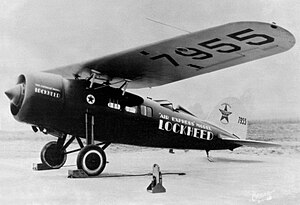Lockheed Vega
| Lockheed Vega | |
|---|---|
 Lockheed Air Express |
|
| Type: | Airliner |
| Design country: | |
| Manufacturer: | |
| First flight: |
4th July 1927 |
| Commissioning: |
1928 |
| Number of pieces: |
132 |

The Lockheed Vega and the Lockheed Air Express derived from it were commercial aircraft made by the US American manufacturer Lockheed .
history
The aim of the development was to manufacture and manufacture an unrivaled fast aircraft for Lockheed's own airline. The first flight of the machine took place on July 4, 1927. It was the first step in the development of real high-speed air traffic. The machine was developed by John Northrop . Taking into account the latest aerodynamic findings and using the most powerful engine available, a four-seater type was initially developed. The prototype was bought by William Randolph Hearst and named "Golden Eagle". However, the machine disappeared without a trace during an air race in August of the same year. The second machine was used for demonstrations. The third was bought by Hubert Wilkins for an Arctic expedition. For use on airlines, however, four passenger seats proved to be insufficient in the long run. The machines still sold well and at the national air races in Cleveland in 1928 , the type proved to be extremely successful. Of this original Vega 1, 28 machines were sold.
In order to be able to cover the demand for fast passenger aircraft with adequate transport performance, the draft was revised. The Vega 5 , equipped with a 450 hp Pratt & Whitney R-1340 and a NACA hood , was created in 1929 and reached a cruising speed of 249 km / h and a top speed of 266 km / h. 42 machines could be sold. A total of seven machines were converted from other variants to this standard, five of which were equipped with floats. Two machines were converted into six-seat machines, nine as the Vega 5A business jet .
The next variant was the five-seat Vega 2 with a 300 hp Wright Whirlwind J-6. Six machines of this type were made. Another version was the Vega 2A with six seats, which led to the most popular type Vega 5B with six seats and the 450 hp Pratt & Whitney R-1340 . A total of 34 machines of this type were produced, including three converted land planes and two other types of float planes.
The Vega 5C variant received a more powerful engine and larger control surfaces. A total of 27 machines were converted to this standard, six were newly built as Vega 5C.
A major change in design was the aluminum fuselage DL-1 , the six-seater version built by the Detroit Aircraft Corporation and equipped with the engine of the 5C. This development was carried out by Gerard Vultee , the successor to John Northrop . A total of ten machines of this variant were manufactured.
construction
The Lockheed Vega was a single-engine, unrestrained high-decker in a shell construction with a non-retractable tail wheel landing gear for passenger transport. The machine was driven by a Wright J-5 Whirlwind radial engine . The cruising speed with the 225 hp engine was 193 km / h, the top speed 217 km / h. The well-known Clark-Y was used as the wing profile .
use
In the late 1920s and early 1930s, a variety of airlines used the Vega. The largest operator with eleven machines was the Mexican Lineas Aereas Minervas , ten machines each flew for the Corporacion Aeronautica de Transportes and the Braniff , while most companies only used one to four machines of this type.
A special version was the Lockheed Air Express with a wing separated from the fuselage to meet the requirements of the Western Air Express . The pilot sat behind the passenger cabin in an open cockpit. The machine had a more powerful engine than the Vega. A total of eight machines of this variant were manufactured for various operators, the first of which was delivered in March 1928.
The Lockheed Vega was also used for various record flights, so in the Atlantic crossing from Amelia Earhart and the two-time world flight of Wiley Post .
Several military versions of the Vega existed, the Y1C-12 , Y1C-17, and UC-101 . However, there was only one copy of each of these types.
Technical specifications
| Parameter | Data from the Vega 5C |
|---|---|
| length | 8.38 m |
| span | 12.50 m |
| Wing area | 25.55 m² |
| height | 2.59 m |
| drive | a 9-cylinder radial engine Pratt & Whitney R-1340 Wasp SC with 336 kW (457 hp) |
| Cruising speed | 298 km / h |
| Range | 885 km |
| crew | Pilot + 6 passengers |
| Service ceiling | 5485 m |
| Empty mass | 1163 kg |
| Flight mass | 2155 kg |
See also
literature
- Kenneth Munson, John W. Wood et al .: Airliners from 1919 to the present day. Exeter Books, New York NY 1983, ISBN 0-671-06014-7 .
Web links
- Lockheed Vega 5B, Amelia Earhart. In: Collections. Smithsonian National Air and Space Museum, accessed October 11, 2013 .
